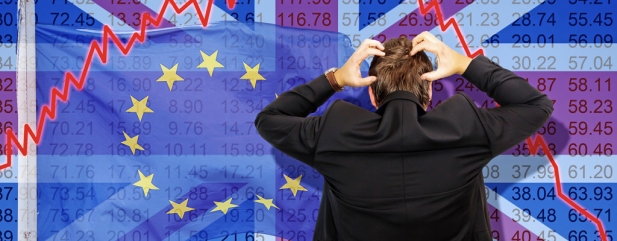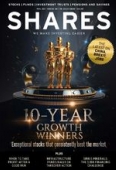Archived article
Please note that tax, investment, pension and ISA rules can change and the information and any views contained in this article may now be inaccurate.
How to respond to any potential sterling crisis

Sterling did not know what to make of Prime Minister Theresa May’s Brexit white paper. It dipped, rallied and then dipped again. Even some chatter about a second interest rate increase within the space of a year from the Bank of England on 2 August is offering little support to the currency, at least at the time of writing.
The pound is thus nowhere near to recapturing the levels it held on the day before the EU referendum in summer 2016 and remains prey to short-term sentiment swings related to the Brexit negotiation process.
Sterling has suffered three crises of confidence since 1945. A repeat cannot be entirely ruled out owing to the current political upheaval and lack of clarity on Brexit, although previous notable plunges have been the result of deep-rooted economic problems rather than any games of musical chairs at Westminster.
1967. Prime Minister Harold Wilson devalued the pound from $2.80 to $2.40 in 1967 as the UK struggled with a rising budget deficit, a trade deficit and a current account deficit, added to a weakening economy. The UK needed to attract capital to fund its triple deficits, or burn through its foreign exchange reserves, and Wilson chose a devaluation to limit national liabilities and lure investment into the UK from overseas.
1976. Sterling took a battering as then-Chancellor of the Exchequer Denis Healey had to turn to the International Monetary Fund for an emergency loan.
Britain was struggling with weak growth, an inflation rate in the mid-teens and – once more – the combination of a growing budget deficit, trade deficit and thus current account deficit. Gilts were unattractive to buyers thanks to inflation and thus the Government turned to external help for near-term funding. Ironically, the IMF loan was paid back quickly as Treasury estimates for the 1976-77 budget deficit proved far too pessimistic.
1992. The currency was forced out of the Exchange Rate Mechanism (ERM) in September 1992 when in the care of the Conservative administration of John Major and Norman Lamont. The UK was mired in recession, burdened by what was seen as an uncompetitive, fixed rate relative to the German mark. The devaluation undid 1990’s move to join the ERM and demolished a key plank of the Major government’s European policy.
BACK TO THE FUTURE
There are potential similarities between those three instances and the economic circumstances of today.
The UK is still running an uncomfortably high trade and current account deficit. Thankfully the annual budget deficit is coming down but Britain is still to a degree reliant upon the kindness of strangers to fund itself, to use Bank of England Governor Mark Carney’s words.
Europe was a massive political issue for the Conservative government of the early 1990s and it is every bit as hot a potato today, given how split the party is over the issue of Brexit and how best to implement the withdrawal from the EU mandated by the referendum vote of 2016.
Thankfully there are differences, too
There is no fixed exchange rate to defend, unlike 1967 and 1992, so the Bank of England does not have a big target on its back.
Interest rates are still near rock-bottom levels, so it easier for the UK to fund its borrowings.
The annual budget deficit has come down a lot over the past few years, even if Chancellor Hammond has pushed out plans to actually balance the budget to an unspecified date in the next decade.
It is therefore hard to say that a new sterling crisis is inevitable although the pound does seem to trade as if it prefers a ‘soft’ Brexit to a ‘hard’ one and particularly to ‘no deal’.
Given the prevailing uncertainty in Westminster over the fate of the Prime Minister and the policy framework outlined at Chequers, the pound could remain under pressure.
PORTFOLIO IMPLICATIONS
The performance of the FTSE All-Share before and after those prior crises – and also after the EU referendum of 2016 – could offer some guidance as to what may happen in the event sterling comes under the cosh once more.
In the run-up to 1967 the market did well but then ran out of steam afterwards as interest rates rose to combat inflation.
In the cases of 1976 and 1992, the economy had been struggling but then picked up speed helped by falls in the pound and a lowering of interest rates, to the benefit of share prices.
In 2016 the FTSE All-Share initially tumbled upon news that Britain had voted to leave but then rallied as the heavyweight multinationals and overseas earners of the FTSE 100 in particular dragged it higher. Their foreign assets and income were instantly made more valuable once they were assessed in terms of pounds and pence, thanks to the pound’s post-vote plunge.
If investors are convinced that debate in Westminster – and subsequent negotiations with the EU-27 – will result for any reason in a weaker pound then another option is to look at buying overseas assets, either directly or through a fund, as their value will rise when translated back into pounds.
However, any such trades bring in other risks, including that their price could fall more than the pound, leaving the client worse off than when they started, and, ultimately, basing a strategy purely on currencies is a mug’s game, given how unpredictable they are.
The best reasons for seeking exposure to any asset are (under)valuation and its potential to generate long-term total returns that more than compensate for the risk of holding it. Any currency tailwind is a bonus and no more.
Russ Mould, investment director, AJ Bell
Important information:
These articles are provided by Shares magazine which is published by AJ Bell Media, a part of AJ Bell. Shares is not written by AJ Bell.
Shares is provided for your general information and use and is not a personal recommendation to invest. It is not intended to be relied upon by you in making or not making any investment decisions. The investments referred to in these articles will not be suitable for all investors. If in doubt please seek appropriate independent financial advice.
Investors acting on the information in these articles do so at their own risk and AJ Bell Media and its staff do not accept liability for losses suffered by investors as a result of their investment decisions.

 magazine
magazine













